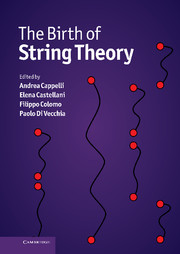Book contents
- Frontmatter
- Contents
- List of contributors
- Photographs of contributors
- Preface
- Abbreviations and acronyms
- Part I Overview
- EARLY STRING THEORY
- Part II The prehistory: the analytic S-matrix
- Part III The Dual Resonance Model
- 10 Introduction to Part III
- 11 From the S-matrix to string theory
- 12 Reminiscence on the birth of string theory
- 13 Personal recollections
- 15 Early string theory at Fermilab and Rutgers
- 15 Dual amplitudes in higher dimensions: a personal view
- 16 Personal recollections on dual models
- 17 Remembering the ‘supergroup’ collaboration
- 18 The ‘3-Reggeon vertex’
- Part IV The string
- TOWARDS MODERN STRING THEORY
- Part V Beyond the bosonic string
- Part VI The superstring
- Part VII Preparing the string renaissance
- Appendix A Theoretical tools of the Sixties
- Appendix B The Veneziano amplitude
- Appendix C From the string action to the Dual Resonance Model
- Appendix D World-sheet and target-space supersymmetry
- Appendix E The field theory limit
- Index
16 - Personal recollections on dual models
from Part III - The Dual Resonance Model
Published online by Cambridge University Press: 05 May 2012
- Frontmatter
- Contents
- List of contributors
- Photographs of contributors
- Preface
- Abbreviations and acronyms
- Part I Overview
- EARLY STRING THEORY
- Part II The prehistory: the analytic S-matrix
- Part III The Dual Resonance Model
- 10 Introduction to Part III
- 11 From the S-matrix to string theory
- 12 Reminiscence on the birth of string theory
- 13 Personal recollections
- 15 Early string theory at Fermilab and Rutgers
- 15 Dual amplitudes in higher dimensions: a personal view
- 16 Personal recollections on dual models
- 17 Remembering the ‘supergroup’ collaboration
- 18 The ‘3-Reggeon vertex’
- Part IV The string
- TOWARDS MODERN STRING THEORY
- Part V Beyond the bosonic string
- Part VI The superstring
- Part VII Preparing the string renaissance
- Appendix A Theoretical tools of the Sixties
- Appendix B The Veneziano amplitude
- Appendix C From the string action to the Dual Resonance Model
- Appendix D World-sheet and target-space supersymmetry
- Appendix E The field theory limit
- Index
Summary
1968. We were young. Revolution was in the air. Gabriele Veneziano's paper [Ven68] was an event in that eventful year. It was immediately clear that it was an important result, but very few people would have thought of it as the beginning of an entirely new theoretical approach that was going to grow in the shell of the old one. It seems appropriate to me to try to combine in this Chapter my personal recollections of the days of the birth of string theory with a few observations on a change in perspective that occurred in theoretical physics. It is a change that we expected in society and that we have witnessed in the course of the years in physics.
It is enough to look at the high energy physics titles of the W. A. Benjamin series Frontiers in Physics, that started in 1961, to get the feeling of the early Sixties: in the first year, Geoffrey F. Chew's S-Matrix Theory of Strong Interactions; in 1963, Regge Poles and S-Matrix by S. C. Frautschi, Mandelstam Theory and Regge Poles by R. Omnès and M. Froissart, together with Complex Angular Momenta and Particle Physics by E. J. Squires; in 1964, Strong-Interaction Physics by M. Jacob and G. F. Chew. Chew's Analytic S-Matrix, with its openly programmatic subtitle A Basis for Nuclear Democracy, was published in 1966, again by Benjamin. In order to complete the list one has to add to these S-matrix inspired titles only a few books, among which is The Eightfold Way by M. Gell-Mann and Y. Ne'eman.
- Type
- Chapter
- Information
- The Birth of String Theory , pp. 202 - 207Publisher: Cambridge University PressPrint publication year: 2012



